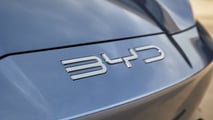
Stop me if you’ve heard this one before. Legacy car manufacturers have been dawdling when it comes to electric vehicles, and when they did make ‘em happen, their offerings were either too expensive or didn’t give buyers a big reason to switch from gas. While they’ve been getting it wrong, China’s been catching up.
All old news, right? But you can’t understand how good some of China’s EVs are until you get behind the wheel of one. That’s how I found myself in a BYD Seal, a direct competitor to the Tesla Model 3, from an automaker stealing sales from, well, everyone. Here’s what I found out.

(Full Disclosure: I asked BYD if I could borrow a top-of-the-line Seal for a few days and its team said yes. It arrived at my house, shiny and clean with a nearly full battery, and was taken away less clean and with around the same amount of charge a few days later. I took it to the countryside, on the highway, and around town.)
BYD Vs. The World
The BYD Seal is a smallish sedan that looks good, has space by the bucketload, promises huge range, and is capable (if you spec the right one) of going very fast indeed. It also comes with plenty of toys, a few party pieces, and an interior that feels fantastic. Here in the UK, the single motor car starts at £45,695 ($57,100), while the dual motor model I had to play in is £48,695 ($61,000). Bearing in mind a top-spec Volkswagen ID.4 GTX is £53,205 (or $67,900 ish) and comes with flaws, the BYD looks mighty appealing before you get anywhere near one in the metal.

No matter which of the two you go for, you’ll get decent performance and range from its 80kWh (usable) Blade battery. The Blade battery is BYD’s homegrown power solution - cells are arranged in thin blades, which means better energy density in less space. It’s also been tested to the Nth degree for safety - fire, penetration, crushing, you name it, BYD’s tested it.
The result is, BYD says, better range and a safe slab o' power. The rear motor car nets you 354 miles on a charge and 313 hp, while the dual motor gets you 323 miles and a rather silly 530 hp. BYD says you’ll crack 0-62mph in 3.8 seconds with two motors on board, and it’s so proud of that fact you’ll find "3.8" on a rear-mounted badge.

In person, it’s undeniably handsome. It swoops in the right places, has some neat aero features, and the bright ‘vents’ that flank its nose help bring its visual weight down. Park it in a regular car park and it doesn’t blend in, but, in Test Car White at least, it doesn’t stand out either. It looks great, and just flashy enough to turn heads.
Of course, in the UK, BYD’s still very much a new player, so some of those head turns will be from people wondering what the hell it is. At least, as with some early BYDs on British roads, it doesn’t say ‘BUILD YOUR DREAMS’ in big letters down the back. That would push it firmly into "naff" territory.
Inside And Tech

Inside it feels plush. There are few nasty plastics, instead tactile materials, and a design that leans futuristic without giving you an overwhelming impression that it’ll age horribly. Some of the touch points on the center console can feel a bit tacky to use though, and there’s a hint of fingerprint magnet piano black there as well.
On the move, you’ve got two screens to keep an eye on. A 10.25-inch instrument display that gives you efficiency, speed, and range info is where most of your attention will be. It’s crisp and clear, though I found its chosen efficiency metric—kWh/100km—not to my taste and couldn’t change it. The Dual Motor "Excellence" I had on test also gets a heads-up display, which did its job nicely.

The star of the interior show is the 15.65-inch central display. It’s huge, clear, and lightning-quick. I suspect the moment VW head office had a go several engineers broke down in tears. The UI leans more toward being functional than exciting, but you can navigate it pretty easily, too… no matter which orientation it’s in. At the press of a button, you can rotate your screen from landscape to portrait and back. It’s a very cool trick a couple of times. After cooing over its swirliness you’ll probably end up leaving it in one or the other and not bothering it again, apart from occasionally showing off to passengers.





It all sounds pretty rosy, huh? Kinda. In the first 20 minutes of driving it, I shouted at it at least four times. The first was because the indicator stalk is on the right of the ‘wheel, not the left, so rather than letting other road users where I was going I was cleaning my windshield. (Yes, even with the steering wheels on the right here, our stalks are the same as yours, Americans.)
I slowly got used to it, but regularly repeated my mistake and it irritated me immensely. Then, the inbuilt nav decided to take me on a route that landed me straight in heavy traffic, when a clearer cut-through was available. This caused rage.
Trying to deftly swap from BYD’s nav to Google Maps via Apple CarPlay I nudged the wrong bit of the screen and ended up rotating it instead of switching apps. As there’s no haptic feedback on the screen it’s easy to hit the wrong thing when your eyes are on the road. The rage doubled. At one point the AEB (autonomous emergency braking) jumped in to stop me from turning because it thought a car nowhere near me was going to hit me. That wasn’t going to happen. At all.

Its final, and perhaps most egregious irritant is its speed limit warning. The Seal reads road signs and sets its parameters based on them. It had seen a 20 mph limit, but I was in a 30 zone, and every time I went above 20 it bonged at me until it got fed up and a voice from within the bowels of the car told me that I was breaking the limit. I wasn’t. But I was cross.
For a good stretch on the highway, it was convinced the limit was 40 mph because it had read a sign… somewhere. BYD, I already have a mother and she’s not as persnickety about speed limits. Take a day off. Please.
On The Road

Once my various anger issues had sorted themselves out, I settled into some mixed roads. Plenty of EVs have optimistic range meters, which we know all too well, but the Seal appeared to be as accurate as they come. On a drizzly, gray, 57-degree day, playing in its various drive modes, my mileage matched up with the counter perfectly every time. It didn’t punish me for using the heated seat, heater, or anything. Whether it manages the same feat during a horrid British winter remains to be seen, but on a typical spring day, it earned my trust. I managed to get between 2.5-3.4 miles/kWh in varied driving.

In town, it’s naturally sedate, and thanks to light controls you rarely struggle to fit it down narrow gaps or overtake a pulled-in bus. A neat 12-speaker Dynaudio sound system ensured my tunes were neatly breezed into my ears, too. The highway, again, was a fine experience. BYD’s sound-deadening team did a bang-up job ensuring occupants are barely bothered by the outside world. If at any point I needed more power, a gentle nudge of the fun pedal in any of the three modes - Eco, Normal, Sport - got me up to speed with delicious urgency.
Each of the three drive modes changes the feel of the car well enough, though for most people leaving it in Eco and trundling around will do the job nicely. The car doesn’t feel artificially throttled, and the gain in feel that Normal gives doesn’t enhance the experience in a life-changing way. As is the case with many EVs, if Normal mode wasn’t there I wouldn’t lose any sleep.

Sport mode is fun. The Seal finds a burst of energy and becomes INCREDIBLY quick. It’s not a lightweight sports car, and you do feel the weight of the thing, but you can have some fun if you find the right roads. It rides smoothly enough, but it errs on the side of ‘sporting,’ which really translates to occasionally lumpy. You can live with it, but there are smoother cars out there. The steering isn’t the sweetest in the world, but few family sedans can claim to be truly engaging, ICE or otherwise. I had fun, but didn’t feel I needed the full beans. Perhaps the rear motor car would suit a little better.
Unlike a lot of cars in its class, I didn’t leave the Seal and then immediately forget about it. The drive didn’t set my world alight, but I was never bored by it. It was comfortable enough, and I never worried the range was going to plummet and leave me stranded. And it does ‘quick’ well. It’s far from foible-free, though.
Verdict

You get the impression that not only has BYD been keeping an eye on the rest of the world, but that it’s identified exactly what makes the popular EVs on offer so appealing. Take Hyundai’s Ioniq 6 as an example —both look good, drive wonderfully, and things just… work. The Hyundai’s cabin can feel a little more cramped than the Seal’s thanks to its whacking great battery (chalk a victory up for the Blade battery), but its infotainment UI is far more pleasing to look at.
There’s much shouting about Chinese EVs at the moment. Some about how they’re built, how they’re funded, how they’ll make their mark on the US market, and more. We should all be paying attention to the discourse surrounding them. The bottom line here is that BYD has made a car that’s good to drive, doesn’t cost the earth, looks great, and is a truly viable alternative to what’s out there. If your wallet was itching, and it happened to be sold where you live, the BYD Seal would almost certainly be on your list.
Alex Goy is a freelance journalist based in London. He likes tea, British sports cars, and the feeling of the mild peril that only owning a British sports car can bring to your day.
Gallery: 2024 BYD Seal Review














